Pierre-Alexandre Mattei
MAASAI, UCA,3iA Côte d'Azur
Parsimonious Gaussian mixture models with piecewise-constant eigenvalue profiles
Jul 02, 2025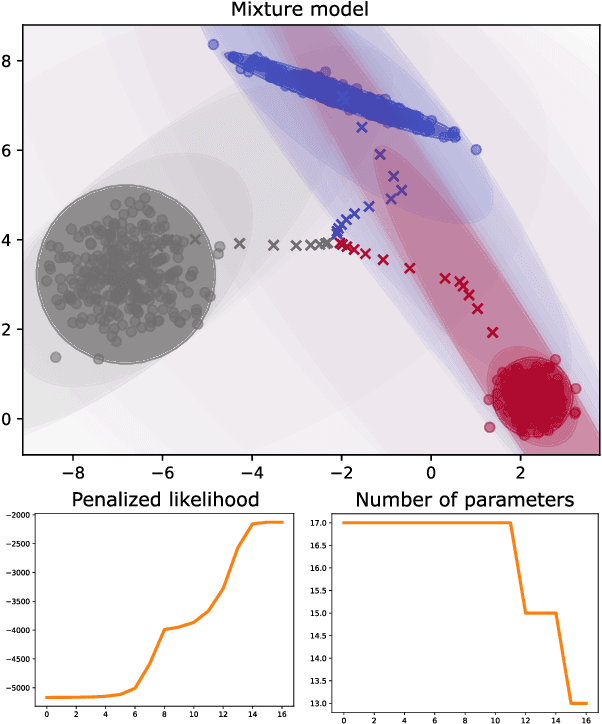



Abstract:Gaussian mixture models (GMMs) are ubiquitous in statistical learning, particularly for unsupervised problems. While full GMMs suffer from the overparameterization of their covariance matrices in high-dimensional spaces, spherical GMMs (with isotropic covariance matrices) certainly lack flexibility to fit certain anisotropic distributions. Connecting these two extremes, we introduce a new family of parsimonious GMMs with piecewise-constant covariance eigenvalue profiles. These extend several low-rank models like the celebrated mixtures of probabilistic principal component analyzers (MPPCA), by enabling any possible sequence of eigenvalue multiplicities. If the latter are prespecified, then we can naturally derive an expectation-maximization (EM) algorithm to learn the mixture parameters. Otherwise, to address the notoriously-challenging issue of jointly learning the mixture parameters and hyperparameters, we propose a componentwise penalized EM algorithm, whose monotonicity is proven. We show the superior likelihood-parsimony tradeoffs achieved by our models on a variety of unsupervised experiments: density fitting, clustering and single-image denoising.
A Tutorial on Discriminative Clustering and Mutual Information
May 07, 2025Abstract:To cluster data is to separate samples into distinctive groups that should ideally have some cohesive properties. Today, numerous clustering algorithms exist, and their differences lie essentially in what can be perceived as ``cohesive properties''. Therefore, hypotheses on the nature of clusters must be set: they can be either generative or discriminative. As the last decade witnessed the impressive growth of deep clustering methods that involve neural networks to handle high-dimensional data often in a discriminative manner; we concentrate mainly on the discriminative hypotheses. In this paper, our aim is to provide an accessible historical perspective on the evolution of discriminative clustering methods and notably how the nature of assumptions of the discriminative models changed over time: from decision boundaries to invariance critics. We notably highlight how mutual information has been a historical cornerstone of the progress of (deep) discriminative clustering methods. We also show some known limitations of mutual information and how discriminative clustering methods tried to circumvent those. We then discuss the challenges that discriminative clustering faces with respect to the selection of the number of clusters. Finally, we showcase these techniques using the dedicated Python package, GemClus, that we have developed for discriminative clustering.
Learning Energy-Based Models by Self-normalising the Likelihood
Mar 10, 2025Abstract:Training an energy-based model (EBM) with maximum likelihood is challenging due to the intractable normalisation constant. Traditional methods rely on expensive Markov chain Monte Carlo (MCMC) sampling to estimate the gradient of logartihm of the normalisation constant. We propose a novel objective called self-normalised log-likelihood (SNL) that introduces a single additional learnable parameter representing the normalisation constant compared to the regular log-likelihood. SNL is a lower bound of the log-likelihood, and its optimum corresponds to both the maximum likelihood estimate of the model parameters and the normalisation constant. We show that the SNL objective is concave in the model parameters for exponential family distributions. Unlike the regular log-likelihood, the SNL can be directly optimised using stochastic gradient techniques by sampling from a crude proposal distribution. We validate the effectiveness of our proposed method on various density estimation tasks as well as EBMs for regression. Our results show that the proposed method, while simpler to implement and tune, outperforms existing techniques.
Kernel KMeans clustering splits for end-to-end unsupervised decision trees
Feb 19, 2024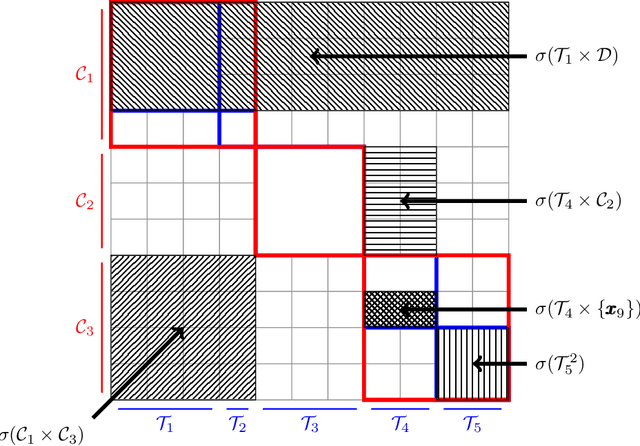
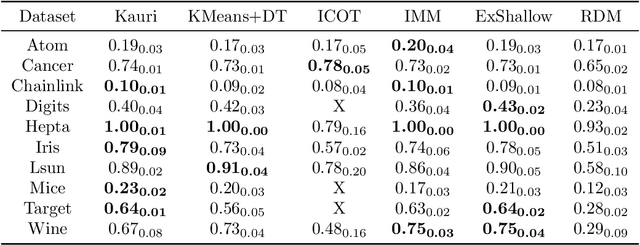
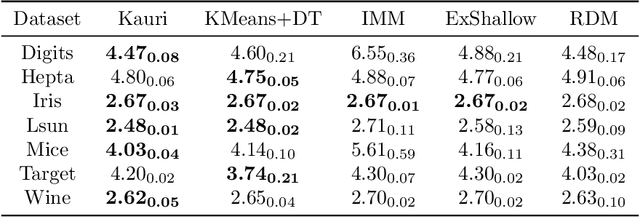

Abstract:Trees are convenient models for obtaining explainable predictions on relatively small datasets. Although there are many proposals for the end-to-end construction of such trees in supervised learning, learning a tree end-to-end for clustering without labels remains an open challenge. As most works focus on interpreting with trees the result of another clustering algorithm, we present here a novel end-to-end trained unsupervised binary tree for clustering: Kauri. This method performs a greedy maximisation of the kernel KMeans objective without requiring the definition of centroids. We compare this model on multiple datasets with recent unsupervised trees and show that Kauri performs identically when using a linear kernel. For other kernels, Kauri often outperforms the concatenation of kernel KMeans and a CART decision tree.
Are ensembles getting better all the time?
Nov 29, 2023Abstract:Ensemble methods combine the predictions of several base models. We study whether or not including more models in an ensemble always improve its average performance. Such a question depends on the kind of ensemble considered, as well as the predictive metric chosen. We focus on situations where all members of the ensemble are a priori expected to perform as well, which is the case of several popular methods like random forests or deep ensembles. In this setting, we essentially show that ensembles are getting better all the time if, and only if, the considered loss function is convex. More precisely, in that case, the average loss of the ensemble is a decreasing function of the number of models. When the loss function is nonconvex, we show a series of results that can be summarised by the insight that ensembles of good models keep getting better, and ensembles of bad models keep getting worse. To this end, we prove a new result on the monotonicity of tail probabilities that may be of independent interest. We illustrate our results on a simple machine learning problem (diagnosing melanomas using neural nets).
Generalised Mutual Information: a Framework for Discriminative Clustering
Sep 06, 2023



Abstract:In the last decade, recent successes in deep clustering majorly involved the Mutual Information (MI) as an unsupervised objective for training neural networks with increasing regularisations. While the quality of the regularisations have been largely discussed for improvements, little attention has been dedicated to the relevance of MI as a clustering objective. In this paper, we first highlight how the maximisation of MI does not lead to satisfying clusters. We identified the Kullback-Leibler divergence as the main reason of this behaviour. Hence, we generalise the mutual information by changing its core distance, introducing the Generalised Mutual Information (GEMINI): a set of metrics for unsupervised neural network training. Unlike MI, some GEMINIs do not require regularisations when training as they are geometry-aware thanks to distances or kernels in the data space. Finally, we highlight that GEMINIs can automatically select a relevant number of clusters, a property that has been little studied in deep discriminative clustering context where the number of clusters is a priori unknown.
Fed-MIWAE: Federated Imputation of Incomplete Data via Deep Generative Models
Apr 17, 2023

Abstract:Federated learning allows for the training of machine learning models on multiple decentralized local datasets without requiring explicit data exchange. However, data pre-processing, including strategies for handling missing data, remains a major bottleneck in real-world federated learning deployment, and is typically performed locally. This approach may be biased, since the subpopulations locally observed at each center may not be representative of the overall one. To address this issue, this paper first proposes a more consistent approach to data standardization through a federated model. Additionally, we propose Fed-MIWAE, a federated version of the state-of-the-art imputation method MIWAE, a deep latent variable model for missing data imputation based on variational autoencoders. MIWAE has the great advantage of being easily trainable with classical federated aggregators. Furthermore, it is able to deal with MAR (Missing At Random) data, a more challenging missing-data mechanism than MCAR (Missing Completely At Random), where the missingness of a variable can depend on the observed ones. We evaluate our method on multi-modal medical imaging data and clinical scores from a simulated federated scenario with the ADNI dataset. We compare Fed-MIWAE with respect to classical imputation methods, either performed locally or in a centralized fashion. Fed-MIWAE allows to achieve imputation accuracy comparable with the best centralized method, even when local data distributions are highly heterogeneous. In addition, thanks to the variational nature of Fed-MIWAE, our method is designed to perform multiple imputation, allowing for the quantification of the imputation uncertainty in the federated scenario.
Are labels informative in semi-supervised learning? -- Estimating and leveraging the missing-data mechanism
Feb 15, 2023Abstract:Semi-supervised learning is a powerful technique for leveraging unlabeled data to improve machine learning models, but it can be affected by the presence of ``informative'' labels, which occur when some classes are more likely to be labeled than others. In the missing data literature, such labels are called missing not at random. In this paper, we propose a novel approach to address this issue by estimating the missing-data mechanism and using inverse propensity weighting to debias any SSL algorithm, including those using data augmentation. We also propose a likelihood ratio test to assess whether or not labels are indeed informative. Finally, we demonstrate the performance of the proposed methods on different datasets, in particular on two medical datasets for which we design pseudo-realistic missing data scenarios.
Sparse GEMINI for Joint Discriminative Clustering and Feature Selection
Feb 07, 2023Abstract:Feature selection in clustering is a hard task which involves simultaneously the discovery of relevant clusters as well as relevant variables with respect to these clusters. While feature selection algorithms are often model-based through optimised model selection or strong assumptions on $p(\pmb{x})$, we introduce a discriminative clustering model trying to maximise a geometry-aware generalisation of the mutual information called GEMINI with a simple $\ell_1$ penalty: the Sparse GEMINI. This algorithm avoids the burden of combinatorial feature subset exploration and is easily scalable to high-dimensional data and large amounts of samples while only designing a clustering model $p_\theta(y|\pmb{x})$. We demonstrate the performances of Sparse GEMINI on synthetic datasets as well as large-scale datasets. Our results show that Sparse GEMINI is a competitive algorithm and has the ability to select relevant subsets of variables with respect to the clustering without using relevance criteria or prior hypotheses.
Explainability as statistical inference
Dec 06, 2022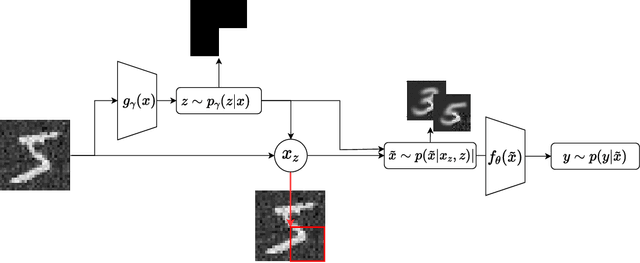

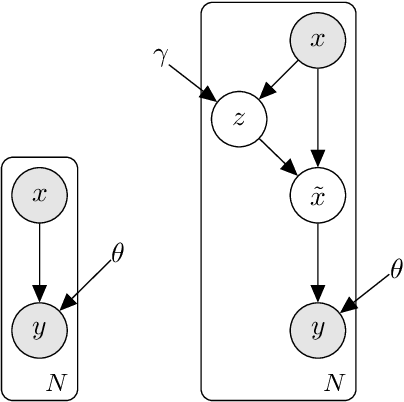
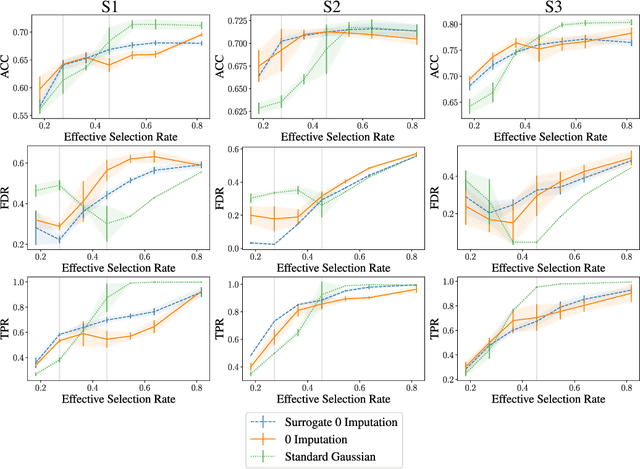
Abstract:A wide variety of model explanation approaches have been proposed in recent years, all guided by very different rationales and heuristics. In this paper, we take a new route and cast interpretability as a statistical inference problem. We propose a general deep probabilistic model designed to produce interpretable predictions. The model parameters can be learned via maximum likelihood, and the method can be adapted to any predictor network architecture and any type of prediction problem. Our method is a case of amortized interpretability models, where a neural network is used as a selector to allow for fast interpretation at inference time. Several popular interpretability methods are shown to be particular cases of regularised maximum likelihood for our general model. We propose new datasets with ground truth selection which allow for the evaluation of the features importance map. Using these datasets, we show experimentally that using multiple imputation provides more reasonable interpretations.
 Add to Chrome
Add to Chrome Add to Firefox
Add to Firefox Add to Edge
Add to Edge